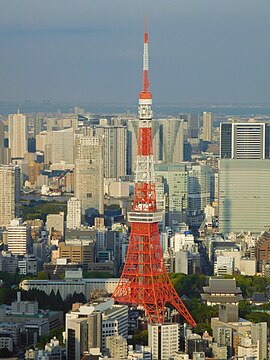| Tokyo Tower | |
|---|---|
東京タワー | |
 | |
 Tokyo Tower in 2023 | |
 | |
| General information | |
| Status | Completed |
| Type | Communications tower Observation tower |
| Location | 4-2-8 Shiba-koen, Minato, Tokyo 105-0011 |
| Coordinates | 35°39′31″N 139°44′44″E / 35.65861°N 139.74556°E |
| Construction started | June 1957 |
| Topped-out | 14 October 1958 |
| Completed | 1958 |
| Opening | 23 December 1958 |
| Cost | ¥2.8 billion (US$8.4 million in 1958) |
| Owner | The Tokyo Tower Company (controlling shareholder: Toei Company and Mother Farm) |
| Height | |
| Architectural | 333 m (1,093 ft) |
| Antenna spire | 332.9 m (1,092 ft)[2] |
| Top floor | 249.6 m (819 ft) |
| Observatory | 249.6 m (819 ft) |
| Technical details | |
| Floor count | 15 |
| Lifts/elevators | 4 |
| Design and construction | |
| Architect(s) | Tachū Naitō[1] |
| Structural engineer | Nikken Sekkei Ltd.[3] |
| Main contractor | Takenaka Corporation[1] |
| Website | |
| www | |
Tokyo Tower (東京タワー, Tōkyō Tawā, pronounced [toːkʲoː taɰᵝaː] ), officially Japan Radio Tower (日本電波塔, Nippon denpatō) is a communications and observation tower in the district of Shiba-koen in Minato, Tokyo, Japan, completed in 1958. At 332.9 meters (1,092 ft), it was the tallest tower in Japan until the construction of Tokyo Skytree in 2012. It is a lattice tower inspired by the Eiffel Tower, and is painted white and international orange to comply with air safety regulations.
The tower's main sources of income are tourism and antenna leasing. FootTown, a four-story building directly under the tower, houses museums, restaurants, and shops. Departing from there, guests can visit two observation decks. The two-story Main Deck (formerly known as the Main Observatory) is at 150 meters (490 ft), while the smaller Top Deck (formerly known as the "Special Observatory") reaches a height of 249.6 meters (819 ft). The names were changed following renovation of the top deck in 2018.[4] The tower is repainted every five years, taking a year to complete the process.
In 1961, transmission antennae were added to the tower. They are used for radio and television broadcasting and now broadcast signals for Japanese media outlets such as NHK, TBS Television, and Fuji Television. The height of the tower was not suitable for Japan's planned terrestrial digital broadcasting planned for July 2011, and for the Tokyo area. A taller digital broadcasting tower, known as Tokyo Skytree, was completed on 29 February 2012. Tokyo Tower has become a prominent landmark in the city, and frequently appears in media set in Tokyo.
- ^ a b "Tokyo Tower". Emporis. Archived from the original on 11 June 2004. Retrieved 11 April 2008.
{{cite web}}: CS1 maint: unfit URL (link) - ^ "Tokyo Tower gets shorter for the 1st time". Retrieved 23 July 2012.
- ^ "Structural Engineering". Nikken Sekkei. Archived from the original on 21 April 2008. Retrieved 11 April 2008.
- ^ "Grand opening of Tokyo Tower's Top Deck (250 m), and Main Deck (150 m) renovation. | TokyoTower". www.tokyotower.co.jp. Retrieved 18 July 2018.